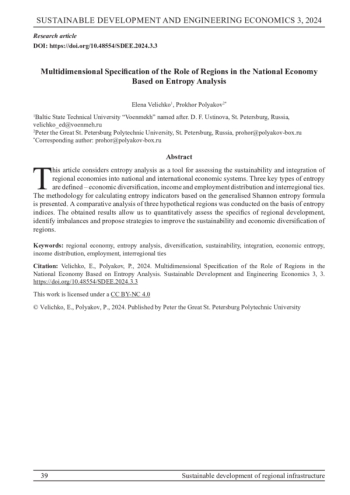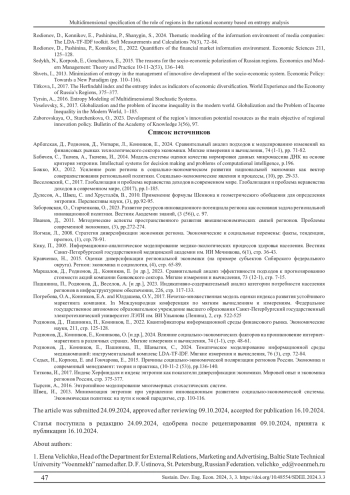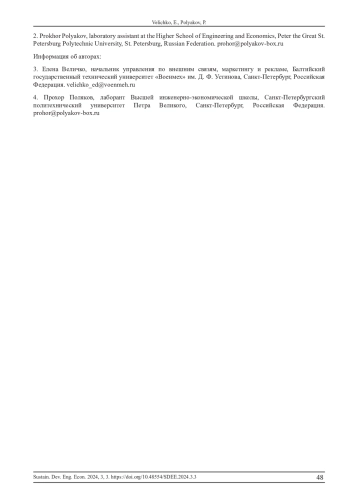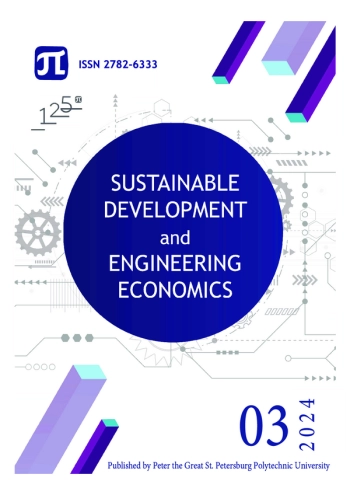This article considers entropy analysis as a tool for assessing the sustainability and integration of regional economies into national and international economic systems. Three key types of entropy are de ned - economic diversi cation, income and employment distribution and interregional ties. The methodology for calculating entropy indicators based on the generalised Shannon entropy formula is presented. A comparative analysis of three hypothetical regions was conducted on the basis of entropy indices. The obtained results allow us to quantitatively assess the speci cs of regional development, identify imbalances and propose strategies to improve the sustainability and economic diversi cation of regions.
Идентификаторы и классификаторы
Analysing the role of regions in the national economy is one of the key tasks of the regional economy. The issues of diversification of economic structures, equitable income distribution and integration of regions into interregional and international economic relations require an integrated approach (Zaborovskaya and Starchenkova, 2023). In the context of the growing complexity of economic processes, the use of methods that make it possible to assess multidimensional relationships in economic systems is becoming particularly relevant (Rodionov et al., 2022).
Список литературы
1. Арбатская, Д., Родионов, Д., Унгвари, Л., Конников, Е., 2024. Сравнительный анализ подходов к моделированию изменений на финансовых рынках технологического сектора экономики. Мягкие измерения и вычисления, 74 (1-1), pp. 71-82.
2. Бабичев, С., Ткачев, А., Ткачева, И., 2014. Модель системы оценки качества нормировки данных микромассива ДНК на основе критерия энтропии. Intellectual systems for decision making and problems of computational intelligence, p.196.
3. Божко, Ю., 2012. Усиление роли региона в социально-экономическом развитии национальной экономики как вектор совершенствования региональной политики. Социально-экономические явления и процессы, (10), pp. 29-33. EDN: PZRQUV
4. Веселовский, С., 2017. Глобализация и проблема неравенства доходов в современном мире. Глобализация и проблема неравенства доходов в современном мире, (2017), pp.1-185.
5. Дулесов, А., Швец, С. and Хрусталёв, В., 2010. Применение формулы Шеннона и геометрического обобщения для определения энтропии. Перспективы науки, (3), pp.92-95. EDN: NPVJCT
6. Заборовская, О., Старченкова, О., 2023. Развитие ресурсов инновационного потенциала региона как основная задача региональной инновационной политики. Вестник Академии знаний, (3 (56)), с. 97.
7. Иванов, Д., 2011. Методические аспекты пространственного развития внешнеэкономических связей регионов. Проблемы современной экономики, (3), pp.272-274.
8. Иогман, Л., 2008. Стратегия диверсификации экономики региона. Экономические и социальные перемены: факты, тенденции, прогноз, (1), стр.78-91.
9. Кику, П., 2005. Информационно-аналитическое моделирование медико-экологических процессов здоровья населения. Вестник Санкт-Петербургской государственной медицинской академии им. ИИ Мечникова, 6(1), стр. 36-43.
10. Кравченко, Н., 2015. Оценки диверсификации региональной экономики (на примере субъектов Сибирского федерального округа). Регион: экономика и социология, (4), стр. 65-89.
11. Маршалов, Д., Родионов, Д., Конников, Е. [и др.], 2023. Сравнительный анализ эффективности подходов к прогнозированию стоимости акций компании банковского сектора. Мягкие измерения и вычисления, 73 (12-1), стр. 7-15.
12. Пашинина, П., Родионов, Д., Веселов, А. [и др.], 2023. Индикативно-содержательный анализ категории потребности населения регионов в инфраструктурном обеспечении, 226, стр. 117-133. EDN: LUEOND
13. Погребова, О.А., Конников, Е.А. and Юлдашева, О.У., 2017. Нечетко-множественная модель оценки индекса развития устойчивого маркетинга компании. In Международная конференция по мягким вычислениям и измерениям. Федеральное государственное автономное образовательное учреждение высшего образования Санкт-Петербургский государственный электротехнический университет ЛЭТИ им. ВИ Ульянова (Ленина), 2, стр. 522-525.
14. Родионов, Д., Пашинина, П., Конников, Е., 2022. Квантификаторы информационной среды финансового рынка. Экономические науки, 211, стр. 125-128. EDN: WBAPHW
15. Родионов, Д., Конников, Е., Конникова, О. [и др.], 2024. Влияние социально-экономических факторов на проникновение интернет-маркетинга в различных странах. Мягкие измерения и вычисления, 74 (1-1), стр. 48-61.
16. Родионов, Д., Конников, Е., Пашинина, П., Шаныгин, С., 2024. Тематическое моделирование информационной среды медиакомпаний: инструментальный комплекс LDA-TF-IDF. Мягкие измерения и вычисления, 76 (3), стр. 72-84.
17. Седых, Н., Корпош, Е. and Гончарова, Е., 2015. Причины социально-экономической поляризации регионов России. Экономика и современный менеджмент: теория и практика, (10-11-2 (53)), pp.136-140. EDN: UYANHF
18. Титкова, И., 2017. Индекс Херфиндаля и индекс энтропии как показатели диверсификации экономики. Мировой опыт и экономика регионов России, стр. 375-377.
19. Тырсин, А., 2016. Энтропийное моделирование многомерных стохастических систем.
20. Швец, И., 2013. Минимизация энтропии при управлении инновационным развитием социально-экономической системы. Экономическая политика: на пути к новой парадигме, стр. 110-116.
Выпуск
Другие статьи выпуска
The present paper develops an invariant ontology of strategic interaction in a sociotechnical system using game theory tools. In the course of the research, ontologies are considered tools for modelling sociotechnical systems, including tools for social and technical process integration. The demand for these tools derives from the need to integrate people into technical systems as equivalent and equal elements that exert both external and internal influence on the system. Such sociotechnical models have already been applied to describe enterprise information structures, but they lack a description of decision-making between the system elements within the strategic inter-action. As part of the solution to this problem, an ontology-based model of a sociotechnical system describing the interaction of both social and technical elements through game interaction is developed. Each of the participants in the interaction is described in terms of game theory, with the allocation of possible strategies and the corre-sponding winnings. Through the interactive entities within the game theory model, game interaction takes place between the participant and appropriate behaviour strategy selection. The model is a exible, scalable tool for building simulation models of sociotechnical systems. The results obtained will be tested when real sociotechnical systems are built, and the ontology will be re ned according to the results obtained.
Today, in order to develop national economies, it is necessary to pay attention to the economies of the regions of the countries. The regional economy is the basis of the national welfare. In the Russian Federation there are a number of problems with regional development, one of which is the differentiated development of the constituent entities of the Russian Federation. Every year, the difference in development increases due to the rapid growth of large economic regions and the lag in regions removed from the central regions. In the context of such key competition factors, this development becomes competitive in the region. The article examines various concepts of and approaches to regional competitiveness that contribute to the formation of comprehensive economic cooperation. Through analysis of statistics on indicators of the socio-economic development of some regions of the Russian Federation, the reason for the observed disproportion was identified. This reason is the outflow of population. A person with strength and skills is a key part of building a regional economic system. To solve problems that arise in the work, a model for increasing regional competitiveness is proposed, which includes three stages. The first is basic, focusing on building the foundations of production; the second stage involves focusing on the development of science and education; and the third is creative, focused on the development of creative industries. Thus, the model proposed by the author meets the criterion of complexity, as well as the requirements for increasing the competitiveness of regions in the medium and long term, which will contribute to the socio-economic development of the constituent entities of the Russian Federation, balance and balance in the level of development of the country as a whole.
This article focuses on improving the information security of industrial enterprises through the automation of data transmission processes. As a solution, an autonomous unmanned aerial vehicle (UAV) equipped with three microcontrollers is proposed to handle ight control, data processing and transmission and information protection. The system utilises infrared data transmission channels, hardware encryption and a mechanism for the physical destruction of the storage medium, ensuring a high level of protection against cyberattacks and data breaches. The drone’s architecture is isolated from corporate networks and features mobility and autonomy, making it e ective in environments with limited infrastructure. The modular design of the device allows for adaptation to various application scenarios. The research results demonstrate that the proposed solution provides reliable and secure data transmission, enhancing the resilience of enterprises to modern cyber threats.
This paper describes the development of an agile project management system. This research is relevant because of the feature of agile projects consisting of changing requirements. We developed the architecture of the backlog and tasks management system, including a duration prediction module. Using the developed system, managers have the opportunity to divide project processes into sprints depending on the prediction and value for the stakeholders. The authors propose a method for predicting agile project duration by formalising the application of expert Story Point evaluation and subsequent Monte Carlo simulation. Based on the developed method, an algorithm for the dynamic prediction of task duration was designed. Integration of the developed method into the system made it possible to reduce the assumptions and limitations associated with updating user story data and participation in the projects of new and cross-functional teams. The developed system allows managers to cope with agile project bottlenecks.
Статистика статьи
Статистика просмотров за 2025 год.
Издательство
- Издательство
- Политех
- Регион
- Россия, Санкт-Петербург
- Почтовый адрес
- 195251, г.Санкт-Петербург, ул. Политехническая, дом 29
- Юр. адрес
- 195251, г Санкт-Петербург, Калининский р-н, ул Политехническая, д 29 литера б
- ФИО
- Рудской Андрей Иванович (РЕКТОР)
- E-mail адрес
- office@spbstu.ru
- Контактный телефон
- +7 (812) 2972077
- Сайт
- https://spbstu.ru











